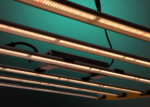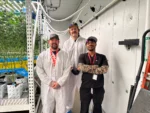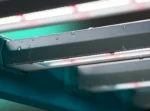For commercial cannabis cultivators, the shift from high-pressure sodium (HPS) lighting to LED technology represents one of the most significant advancements in the industry. While LED fixtures offer better energy efficiency, longer lifespan, and more precise spectral control, the transition itself can be challenging—requiring adjustments in environmental control, plant response, and cultivation strategy.
Enter the BIOS Bridge fixture, an innovative solution designed to make this transition smoother by mimicking key aspects of HPS performance while delivering the efficiency benefits of LED.
In a recent discussion, Nelson Lindsley, plant breeder and founder of Poetry of Plants, shared insights into why this technology matters and how growers can leverage it to optimize their operations.
He says The Bridge fixture was born out of a certain tension in the market. LED lights have become almost industry-standard in the legal U.S. cannabis industry. But growers were still pushing for the bag appeal and cultural norms provided by HPS lighting. How could someone like Nelson and the BIOS team square the matter?
The Bridge fixture, hitting the market in the summer of 2025, delivers a custom HPS-inspired spectrum built with LED durability and performance.
Let’s get into it.
Why the Transition from HPS to LED Isn’t Always Straightforward
Many cultivators have relied on HPS lighting for decades. However, as the industry evolves, energy costs, efficiency demands, and sustainability goals are pushing more growers toward LED solutions. Despite the benefits, moving to LED isn’t a simple plug-and-play upgrade; the transition requires thoughtful planning and diligent execution. The BIOS team can help you meet those challenges.
According to Nelson, growers transitioning from HPS to LED often face:
+ Different light distribution – HPS lights create a downward-focused beam, while many LED systems provide broader, more uniform coverage.
+ Changes in plant metabolism – LED-driven photosynthesis can impact water uptake, transpiration rates, and nutrient absorption.
+ Shifts in heat dynamics – HPS lights emit significant radiant heat, which helps maintain ambient temperatures and evaporation rates. Switching to LED often requires HVAC and dehumidification adjustments.
+ Variability in light intensity – Some LED fixtures deliver high-intensity PPFD, requiring cultivators to recalibrate light positioning and distance.
“One thing that a lot of people early on had to learn the hard way is that it’s not just as simple as switching to LED and then everything’s bing, bam, boom,” Nelson said. “There are a lot of other factors in the room that have to be monitored or modified just from switching from HPS to LED.”
How BIOS’ The Bridge Fixture Makes the Transition Easier
The Bridge fixture was designed specifically to ease this transition by preserving some of the familiar characteristics of HPS while incorporating LED efficiency.
1. Light Spectrum: Familiar, Yet Optimized
HPS lighting is heavily weighted toward the red spectrum, which many growers believe is essential for vigorous flowering and high cannabinoid production. However, LED technology enables a more refined spectral approach that enhances plant response without sacrificing performance.
With the Bridge fixture, BIOS has engineered a spectrum that closely mimics HPS, so growers don’t have to completely rethink their approach. It keeps the familiarity of HPS performance, but it’s optimized to drive stronger photosynthesis efficiency and plant growth stability.
“I started working on trying to get a fixed spectrum fixture,” Nelson explains. “Not a variable spectrum, not a light that had a bunch of bells and whistles. There are problems with having all those bells and whistles. They’re all failure points. Every new feature that’s added on a light is an additional failure point. And we want to make a light that is simple to use and robust and has minimal failure points.”
2. Heat Output: A Balanced Approach
One of the biggest adjustments for growers moving from HPS to LED is managing temperature shifts. HPS fixtures emit a high level of infrared radiation, contributing to the overall room temperature. In contrast, LED fixtures produce less ambient heat, meaning growers often need HVAC recalibrations.
The Bridge fixture takes heat distribution into account. It doesn’t eliminate all the heat like traditional LEDs, but it moderates it, allowing cultivators to ease into HVAC adjustments instead of overhauling their entire environmental system.
“You don’t have that focal point of heat,” Nelson says. “The light isn’t being generated through gas production or through a gas. It’s being generated through electrical energy. There are growers who don’t quite realize how much HPS heat was actually driving their environment. You take that away, and suddenly your humidity spikes, your HVAC system has to work harder, and if you haven’t planned for that, it can be a mess.”
The BIOS team helps walk growers through that transition to ensure nothing goes awry.
3. Light Intensity & Uniformity: Consistency Without Overload
Many commercial LED fixtures provide extremely high-intensity light, which can be overwhelming for plants accustomed to HPS. This can lead to photobleaching, stress, and growth inconsistencies.
The BIOS Bridge fixture maintains similar light intensity levels as HPS, but with improved uniformity. This helps growers adjust without suddenly shocking their plants or having to rework their entire lighting grid.
4. Compatibility With Existing Infrastructure
Retrofitting a facility from HPS to LED often requires new wiring, hanging structures, and electrical modifications—all of which add cost and complexity.
With the Bridge fixture, BIOS has created something that’s easy to integrate into existing HPS setups. That’s a huge advantage because it allows growers to phase in LED adoption gradually without halting production or making immediate large-scale investments.
A Smarter Path to LED Adoption
While the advantages of LED lighting are clear, many growers hesitate to switch due to concerns about crop performance, infrastructure changes, and learning curves. The BIOS Bridge fixture offers a practical, business-savvy approach to LED adoption—helping cultivators transition seamlessly without disrupting yields or efficiency.
For growers who are on the fence about LED, this fixture is a stepping stone, not a leap. It’s a way to keep what’s working while improving efficiency—which, in this industry, is the smartest move you can make.
Key Takeaways: Why the BIOS Bridge Fixture Works
✅ Maintains familiar HPS spectrum, fine-tuned for better plant response.
✅ Manages heat output, reducing HVAC disruptions.
✅ Prevents light intensity overload, ensuring smooth plant adaptation.
✅ Easily integrates into existing HPS setups, avoiding major retrofits.
✅ Gradual transition approach, minimizing risk while improving efficiency.
As commercial growers continue refining their lighting strategies, the BIOS Bridge fixture is proving to be a multi-faceted solution—delivering the best of both worlds for those looking to modernize their operations without unnecessary risk.



